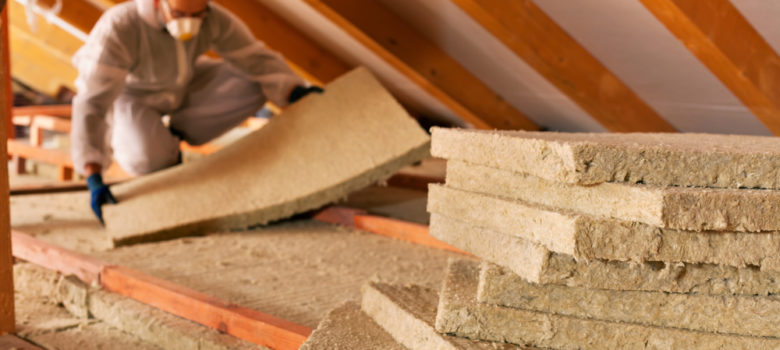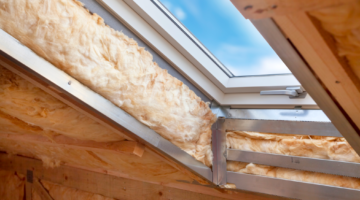
Insulation is a marvellous thing, it keeps us warmer in the winter and means lower energy bills. But with hot summers and extreme heatwaves, a lot of people worry that their insulation is trapping the heat in their homes and making it far too hot.
So what’s the answer?
How does insulation work?
Insulation has one job, and one job only – to slow down heat from transferring from place to another. Depending on what material you’re using, it can be very effective at this.
When the sun hits the wall of your house and warms it up, that’s a type of heat transfer called radiation. Scary word, but all radiation actually means is just heat transferred by electromagnetic waves. The other way you walls warm up is through convection, which is heat in the air coming into contact with your walls and warming it up. Through these two processes, heat and cold can affect your walls.
Insulation utilises the concept of the third and final heat transfer method – conduction. Conduction is when heat is transferred through solid objects – in this instance, the wall of your house. Insulation is made from materials with very low conductivity, meaning that heat won’t move through it very effectively. Low conductivity doesn’t mean no conductivity, so even the best insulation will allow a small amount of heat transfer. This is why insulation is more effective when it’s thicker – it’s further, and harder for the warmth to travel. That’s why, the better the insulation is (ie, the lower it’s conductivity), the less of it you need for the same result.

Does too much insulation make my house too hot?
Well, that’s a complicated question.
Let’s assume that your house is a simple square block, no windows, nothing and no one inside. It’s a boiling hot day, but the insulation is fantastic and there’s lots of it. Inside your (very depressing sounding) house, would be super cool. This is because the insulation, with its low U-value and low conductivity, is not allowing the heat to transfer through the walls. The more insulation you have, the less heat will travel through the walls, and the cooler your home will be.
So, theoretically, insulation will keep you nice and cool in the winter.
The problem with the above example is that nobody actually does live in a square block with no windows and nothing inside. In reality, there are a lot of things that cause the home to warm up:
- Windows! Radiation, which we discussed above, transfers heat as electromagnetic waves until it hits something solid, and not transparent. The suns rays go right through your windows, until they hit the floor and walls inside your house, which they heat up. This is called solar gain, and it’s why your conservatory is hot in summer but your basement is still cold.
- Appliances. Your TV, your mobile phone, your Xbox, your washing machine, your laptop, and worst of all your fridge – all these appliances kick off far more heat than you might realise and warm up the house.
- Cooking. You know what they say, ‘if you can’t stand the heat, get out of the kitchen’. Ovens, hobs, and again, fridge/freezers, all create a whole lot of heat. There’s a reason that chefs are always sweaty.
- You! We’re so used to being warm that we tend not to notice, but even on the coldest day, our warm-blooded bodies give off a significant amount of heat. The more people and pets in the house, the warmer it will be.
- Lighting. Traditional CFL bulbs are incredibly inefficient; only around 10% of the energy they produce comes out as light, with the remaining 90% releasing as heat. That’s why those old-style bulbs can burn you if you touch them while they’re on – they’re effectively small little heaters.
- Heating. It may seem obvious to turn off the heating in the summer, but some people genuinely do forget, or use the central heating to dry their washing.
All these factors are byproducts of living in the modern age, but when we put insulation into the mix then it can be problematic. In a poorly insulated house, as long as it’s cooler outside than inside your house, the heat can move through the walls and dissipate outside. With lots of good insulation, however, the heat is prevented from going anywhere, so it stays inside your house.
The insulation can have an advantage though. If you manage to cool down the inside of your house, with a fan or some other method, a well-insulated home will hold the cold air inside much better.
What should I do if I think that too much insulation is making my house too hot?
The best thing you can do is to tackle all the things avoidable causes of extra heat in your home.
- Draw curtains when you’re not in the room to prevent solar gain
- Turn off your appliances when you’re not using them. When you buy new ones, look for an A+ energy efficiency rating.
- Minimise heat-intensive cooking. If you do want something hot, microwaves work without heating the air, while induction hobs only warm the metal of the pan so they don’t pump out extra heat.
- Turn off lights where you can and switch your old bulbs for LEDs. They are 90% efficient and let off only a small amount of warmth.
- Ensure that your thermostat is turned way down, and that you’re using your heating controls properly.
Get yourself a fan, position it cleverly, and close all the doors to the room that you’re cooling. Once cool, the insulation should help it stay that way.
Think we missed something? Do you have a different opinion?
Comment below to get your voice heard…












So should windows be kept open or closed to keep in the cool? We’ve got old sash windows, and I’m sure that they’re leaking heat like crazy anyway, so I’m inclined to keep them open and just embrace it! But now I’m not so sure??
Open early in the morning, and last thing at night. Otherwise keep them closed and close the curtains.
Belinda – if it’s warmer outside than inside your home, windows closed. If outside has a cool breeze and you’re too hot inside, then open them up!
so why don’t they insulate their homes in hot countreis
Because it doesn’t work in hot countries. Insulation is only for dealing with the cold. For it to work in the summer, you’d need to minimize heat transfer through windows and make sure no devices are creating heat, or at least have a way to vent the heat outside.
I’m thinking of fitting some window film. They can supposedly block about 85% of solar radiation, while not making it too dark, and cling to the window via electrostatic adhesion. They probably won’t cost much for an average sized house and will probably save on cooling costs.
They often have wooden shutters outside and heavy curtains inside
Those that can afford to and can be bothered to will insulate their homes. There is a remarkable difference walking into a well insulated home compared to a non insulated home, in a hot country.
You mention using a fan a couple of times, even stating to close all the doors (windows too I guess you are thinking). Unfortunately this is a very common misconception. Simply put, a fan has no cooling effect apart from evaporative cooling (sweat on your skin drying faster and ‘taking away’ heat as it does so. The energy the fan uses actually adds to the air energy (heats up the room)
Thank you for pointing out that getting a radiant barrier can help balance with your insulation. This was very helpful as well as convenient to use. I have also found this resource Insultech.co.nz useful and its related to what you are mentioning.
Can I fit insulation so efficient that I hardly need heating on
Thank you for your interesting article. I live in a Housing Association Bungalow, originally built from cast concrete! Since the bungalow has been clad with 100cm polystyrene cladding a few years ago, summer heat warms the entire bungalow by a good few uncomfortable degrees. I do all that your article explains and eat and drink cold food and beverages. In addition, I get up at sunrise and open all doors and windows, put fans on, on days when there is a little breeze, the bungalow cools inside. However without a breeze, fans don’t help at all. The indoor air remains the same and stuffy. I have a ceiling fan, an upright Dimplex and a desk fan on the floor in the kitchen. Eg Today, the bungalow remained at 23 degrees all night, with only the the smallest top windows being ajar. It only cooled to 22 between 5.30 and 8.00pm. That’s when I close all windows and doors, hang up a heavy duty white bed cover on the outside of the largest window and adjacent glass door. Put 6 layers of cardboard on south-east facing windows held in place by blinds. Did the same at noon on the north-west facing windows and doors and draw heavy lined curtains. Fans fully on. By 2.00pm the sitting room has warmed up to 25 degrees; outside is 29 degrees. True, there is a huge heatwave this week, and I’m burning 3 lamps to work by, and the fridge is permanently on. Seems amazing to me that they and I are emitting so much heat as to raise the temperature by 3 degrees inside the sitting room! For all that, in pre-Covid years, people coming to visit always commented how cool it is – but this year? It really takes the biscuit! Just don’t know what else to do to lower the heat indoors.
LED light bulbs are not 90% efficient! They use 90% less energy than traditional but they are still only about 30% efficient and still let of most of their energy as heat.
1) Using fans inside a property will actually have a heating effect as there is no air cooling taking place and the motor creates a small amount of heat.
2) Closing curtains will not keep any solar gain outside of the property as, of course, the heat has already entered the house by the time it hits the curtains. External shutters are needed to prevent solar gain through windows.
What is bungalows bungalow gets cold in
Why after getting a new roof with sarking and ployester insulation bats the house is alot hotter and more himid. Before the reroof it was cool on a hot day, rarely needed to use fans.
loooool😂😂😂😂
This is nonsense with a clear agenda – I live is a very well insulated new build. On a hot day it is true that the house stays cooler for longer, but gradually throughout the day the house unavoidably begins to heat up. This article makes it sounds like an insulated house is immune from thermodynamics – it is not. Thermal insulation merely slows down the transfer of heat, it does not stop it. So by 10pm after a hot sunny day, My house stays uncomfortable until around 4am – and it’s no amount of replacement LED lights is going to change that! The UK will soon realise that after insulating all their houses they will all need air-con for the summer.
Wish I had never had internal insulation. Makes it far too hot in summer, it’s stifling..